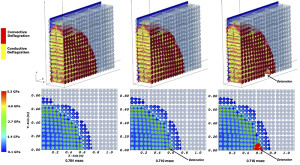Sneak kaboom

Deflagration (top) progresses through the explosive cylinders (light blue) transitioning to detonation (0.710 milliseconds). The dark blue region shows the position of the 2D pressure slice (bottom). (Vizualization: University of Utah and Weber State University.)
The simulation recreated one-eighth of the tractor-trailer’s load of explosives. It revealed that the transition to detonation occurred as the deflagration compacted the explosive material, forming a high-density barrier that trapped the expanding gases.
“As each cylinder expands, they push outward and into each other,” Beckvermit says. “That leads to inertial confinement, a high-density barrier that’s not letting gases escape.” When the pressure reached the critical limit of 5.3 gigapascals, a shock wave formed and moved outward through the bulk of the explosives, detonating nearly the entire load.
Based on their simulations, the team has devised alternative ways of packaging that leave spaces between explosive devices. “That would allow the gases to escape and not build up to the pressures needed for detonation,” Beckvermit says. The group has run simulations of their suggested packaging schemes, which have not yet been tested experimentally.
Gases in motion
A separate research team, led by Alexei Khokhlov at the University of Chicago, is probing the causes of DDT in gas explosions. The problem is different from modeling solid explosives because, in a gas explosion, literally every part is in motion.
Khokhlov and his colleagues have a long history of creating and refining simulation codes modeling DDT in supernovae plasmas as well as earthly gases. Colleagues in this work have included Joanna Austin and Andrew Knisely at the University of Illinois at Urbana-Champaign, Charles Bacon at Argonne.
The collaborators have revealed many of the transition’s secrets. They have recreated processes that cannot be seen in experiments involving actual explosions. In particular, they have discovered the formation of detonation-triggering hot spots that arise when a pressure wave hits burning gas.
“Now the interest is in how the shock is born inside the flame,” Khokhlov says. “That is the question we’re trying to answer.”
The project recently received an award from the Department of Energy INCITE program (Innovative and Novel Computational Impact on Theory and Experiment) of 150 million processor hours on Mira. To run the simulations, Khokhlov, Austin and Marta Garcia at Argonne will use the high-speed combustion and detonation (HSCD) code, which the larger group developed. The team validated the code through an earlier INCITE award.
The group will focus on the most important flammable gases for industrial and public safety, beginning with the simplest case and building in complexity. First, they’ll take on hydrogen, large volumes of which have formed and exploded in nuclear reactor accidents. Second, they’ll study syngas, a mix of hydrogen and carbon monoxide used as a source of clean energy. Finally, they’ll focus on ethylene gases such as ethylene oxide. Ethylene is one of the most widely used hydrocarbons in industry.
The group has succeeded in simulating a transition to detonation. “But there are also discrepancies with the experiments,” Khokhlov says. One reason for disagreement between the model and experiments is that few people have done highly detailed gas-explosion experiments. “We can reproduce the process itself, but not the details of it. The simulation has to match the experiment.”
Khokhlov is confident that the group will make important contributions, now that high-performance computers such as Mira enable them to build models that include all the necessary physics.
“Right now the machines are at the level where you can start to do this modeling in earnest,” he says, adding that the simulations will keep improving as computing power increases. “The beauty of it is that it will become easier and easier over time.”
About the Author
Andy Boyles is a senior science writer at the Krell Institute and contributing science editor at Highlights for Children Inc.




